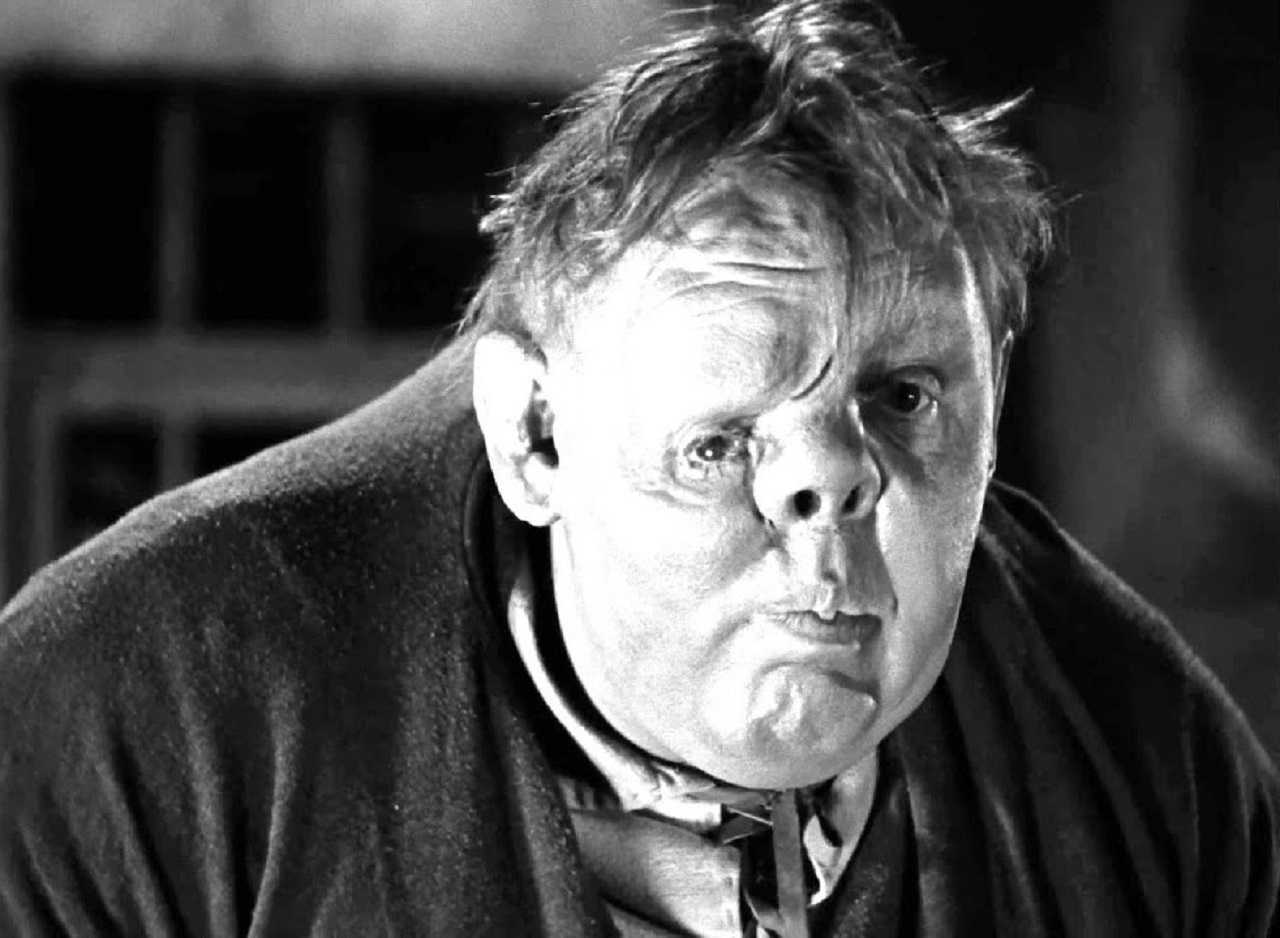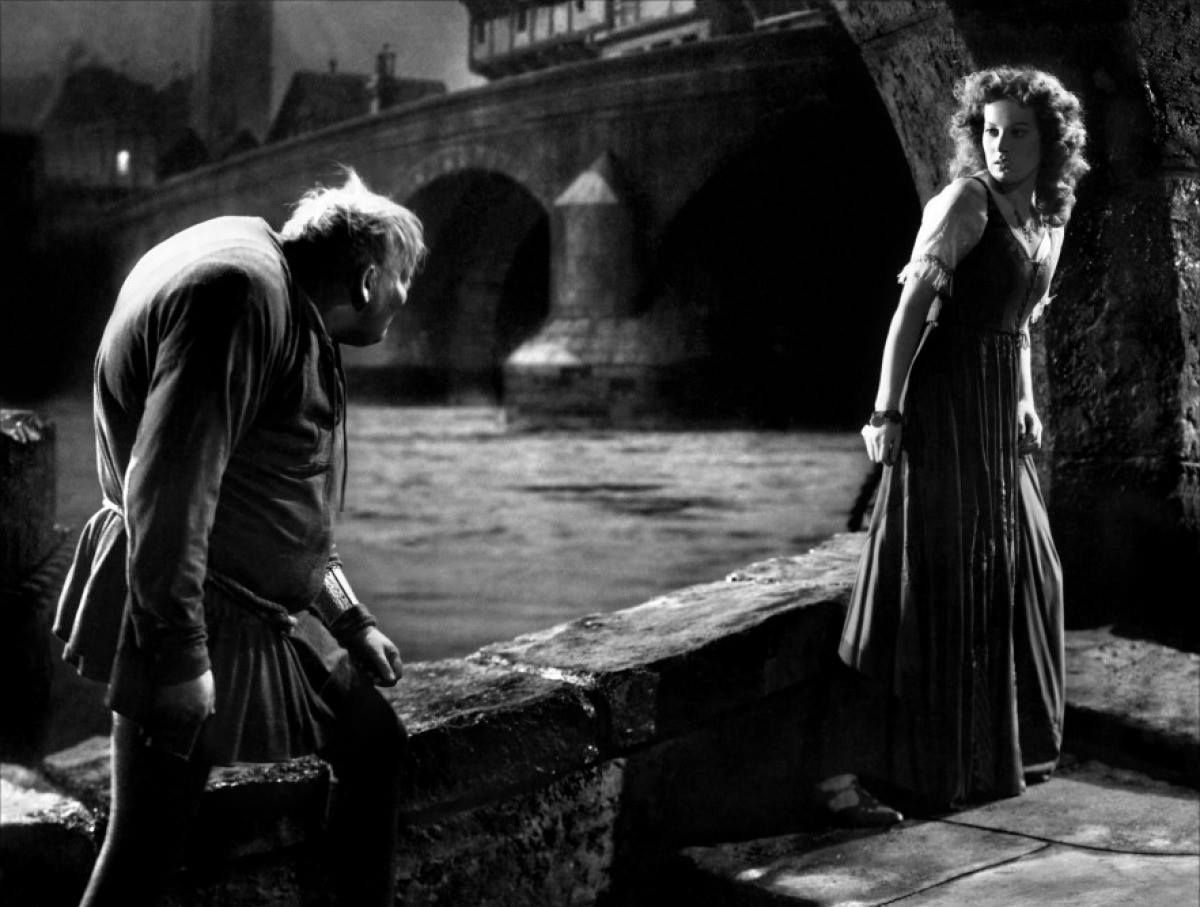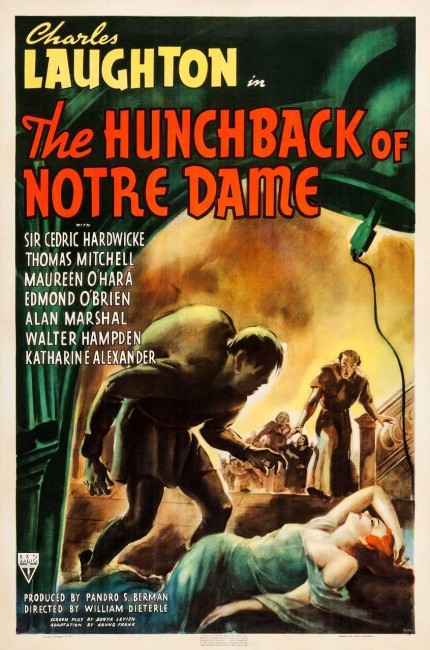USA. 1939.
Crew
Director – William S. Dieterle, Screenplay – Sonia Levien, Adaptation – Bruno Frank, Based on the Novel by Victor Hugo, Producer – Pandro S. Berman, Photography (b&w) – Joseph H. August, Music – Alfred Newman, Photographic Effects – Vernon R. Walker, Makeup – Gordon Bau & Perc Westmore, Art Direction – Van Nest Polglase. Production Company – RKO Radio Pictures.
Cast
Charles Laughton (Quasimodo), Maureen O’Hara (Esmeralda), Sir Cedric Hardwicke (Count Frollo), Edmond O’Brien (Gringoire), Walter Hampden (Archdeacon), Harry Davenport (Louis XI), Thomas Mitchell (Clopin), Alan Marshal (Captain Phoebus)
Plot
Paris at the end of the Hundred Years War. Gypsies are forbidden to enter the city but the beautiful Esmeralda manages to sneak in. When the authorities try to evict her, she seeks refuge in Notre Dame cathedral. The puritanical Count Frollo secretly desires Esmeralda. He kills Esmeralda’s lover and then has her framed and sentenced to be executed for the murder. Instead, the cathedral’s bellringer, the deaf and hunchbacked Quasimodo, snatches her up and takes her to safety because she treated him with kindness. Every section of French society is mobilised in the fight for and against her innocence as Frollo orders the army to break into the cathedral.
Victor Hugo’s novel Notre Dame de Paris/The Hunchback of Notre Dame (1831) is a French literary classic. It has been filmed a number of times, of which the most famous versions have probably been the silent The Hunchback of Notre Dame (1923), which featured one of the classic performances from the great Lon Chaney [Sr], and this sound remake, which will probably remain the definitive version of the book, and then of course the animated Disney bastardisation, The Hunchback of Notre Dame (1996). (See below for the other versions).
Although, Victor Hugo wrote the book as an historical/literary tale, there has been a strong tendency to read the film versions as horror, even though it is only horror by default – the theme of deformity – and the films themselves fall more comfortably into being historical cosume drama and romance rather than any genre-identifying horror tropes. That said, the popularity of the character of Quasimodo has had him placed into the pantheon of Famous Monsters alongside Dracula, the Frankenstein monster, The Phantom of the Opera etc.
This adaptation of the book is an undeniable classic. It was mounted at the height of the so-called Golden Age of Horror and at times the story seems to be cast in the light of the brooding Gothic that informed then recent adaptations of Dracula (1931) and Frankenstein (1931).
There are also times when it is a real oddity. The plot seems to move in odd staccato jumps – one is never sure what subplot each scene is going to take up when it opens and whatever else that may be happening it is going to temporarily put aside. Characters often behave very differently depending on the dictates of the subplot of the moment.

There are also times when the plot comes to a halt so that the historians can climb aboard the pageantry and offer social treatises of the times – one can literally see the guns moving to bring the Church, the nobility and the Age of Reason into their firing line. Everything in the story seems to be performing symbolic function – it is not enough for an Archdeacon to simply gesture out a window at the cathedral, the cathedral has to become a symbol for the ornate ungainliness of France’s Mediaeval past in the same gesture.
Considering all this, it does seem odd when the film starts taking its Catholicism seriously and getting into the beatitudes and with heavenly choirs opening up when Esmeralda prays to the Virgin Mary for guidance. In light of the story’s backing of the Age of Reason, director William Dieterle’s moody Gothic treatment might seem contradictory.
All of that said, it works beautifully as a film. The one thing one notices about William Dieterle is his handling of crowds – no directors other than Sergei Eisenstein and Fritz Lang ever used crowds to such a group mime effect. Dieterle whips the crowds from one side of the screen to the other – they are all naked forces of expression and the effect as giant masses collide on screen is stunning. In one sensationally beautiful shot, the camera hangs near the very apex of the cathedral looking down on the crowd as Charles Laughton holds Maureen O’Hara’s unconscious body up before them – the image is so stark and vivid it hangs there like a primal scream. The design of the cathedral bell tower is magnificent – even if the spectacle seems to be crying out for colour. In shots like the one where Charles Laughton rests beside a gargoyle and puts his head in his hands and cries, the very cathedral itself seems to be echoing his pain.

William Dieterle has the ability amid the spectacle to draw a humanity out of the performances – the scenes between Charles Laughton and Maureen O’Hara are strong and touching. Maureen O’Hara is not distinctive enough a performer to be able to carry the film but Charles Laughton, one of the great character actors of the era, certainly is. His gibbering performance is so controlled, so torturously affecting that one is aware through every moment that it is acting with a capital A. Yet one is surprised to find that it is a performance that contains unexpected touches of self-effacing humour too. The one other performer of distinction is Cedric Hardwicke – the character of Frollo is impressively written and it is joyous watching his coldness slip.
Director William Dieterle was a German immigrant to the US. He made other genre works such as Six Hours to Live (1932), a thriller about a man resurrected from the dead; the Shakespeare adaptation A Midsummer Night’s Dream (1935); the classic All That Money Can Buy/The Devil and Daniel Webster (1941) about a lawyer arguing with The Devil for a farmer’s soul; the classic ghost romance Portrait of Jennie (1948); and the German-made spy thriller/mad scientist film Mistress of the World (1959).
Other film adaptations of the Victor Hugo novel are:– Alice Guy-Blache’s lost silent short Esmeralda (1905); Esmeralda (1922), a lost silent British adaptation with Booth Conway and Sybil Thorndike as Quasimodo and Esmeralda; the silent classic The Hunchback of Notre Dame (1923) with Lon Chaney; the French/Italian-made The Hunchback of Notre-Dame (1956) with Anthony Quinn and Gina Lollobrigida; a BBC tv play The Hunchback of Notre Dame (1977) with Warren Clarke and Michelle Newell; a Hallmark Hall of Fame tv movie The Hunchback of Notre Dame (1982) with Anthony Hopkins and Lesley-Ann Down; the Disney animated The Hunchback of Notre Dame (1996), which produced a sequel with The Hunchback of Notre Dame II (2002); and The Hunchback (1997), a tv movie adaptation with Mandy Patinkin and Salma Hayek. Big Man on Campus (1989). the French-made Quasimodo d’El Paris (1999) and Quasi (2023) are parody/comedy treatments are parodies, while the Hunchback can be seen making a cameo in The League of Extraordinary Gentlemen (2003).
Trailer here
Full film available online here:-

